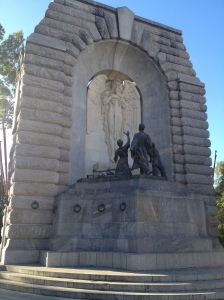The Telegraph is reporting that, a little over nine months after the sarin attack at Ghouta in Syria, high numbers of children in the region are being born with birth defects. These abnormalities, according to activists,
are the result of the chemical weapons used by the Syrian regime last August, said Mr Shaikhani. “Fatma was born congenitally deformed because of exposure to toxic gases and chemicals many times. She is the first case to be registered in the region since the beginning of the revolution. She died few hours after her birth.”
This is troubling news if true.
The big problem is that we have almost no evidence. Not simply that there’s no positive evidence for the claim; that there’s almost no evidence one way or the other.
The National Academies, for example, published a report on the Gulf War and health in 2000, including sarin in their analysis. They found that no evidence existed of reproductive toxicity in animal studies, nor were there any mutagenic effects from sarin exposure. They relied, however, on a small number of studies; the evidence doesn’t point in the right direction, but we also don’t have a lot of evidence to begin with.
Some organophosphates—of which sarin is one—can cause fetal abnormalities. A study conducted after the Iraq-Iran war, for example, found a significant increase in birth defects from victims of chemical attacks. The rub here, however, is that the study couldn’t reliably attribute which chemical weapon was used on whom. It isn’t certain that it is the organophosphate doing the work, some other chemical weapon, both, or something else entirely.
The terrible reality of chemical weapons is that little unclassified research exists about the types of harms—especially long term—that these weapons can inflict. Part of the reason is that they aren’t used very often. But another reason is that it isn’t in the interest of state programs to know about the long-term consequences of chemical weapons. Especially for noncombatants, which include disproportionate numbers of women, children, the elderly, people with chronic illnesses, and so on.
More data would be excellent. It would provide better evidence to use against regimes, and—more importantly, I think—hopefully help us provide better care after a chemical attack. Of course, it is a logistical nightmare and an ethical minefield The utmost care would have to be taken in collecting such data from such vulnerable people, and medical aid would be needed so that they can receive benefit.
I’ll update this as more comes to light.
If you’re a CW person who has more information, please get in touch.


![[A memorial found on the cliffs at Flinders, Victoria. Two plaques adorn the monument, which looks like a great headstone. The upper plaque lists the names of the dead from Flinders who served in World War One; the lower plaque does the same for World War Two. The monument would be substantially bigger if it remembered the wounded, the tortured, and the scarred.]](https://thebrokenspokeblog.files.wordpress.com/2014/04/img_0041.jpg?w=300&h=187)